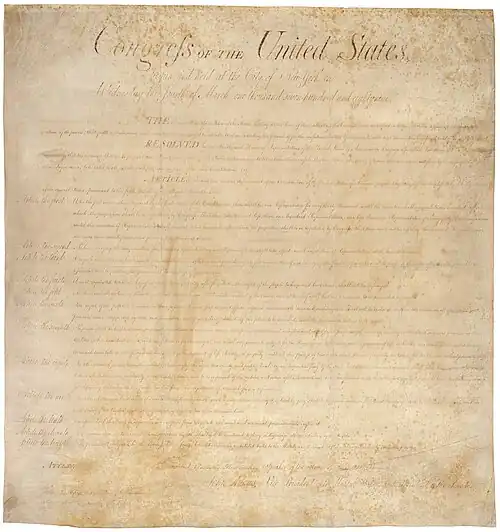The Sakharov Prize for Freedom of Thought, commonly known as the Sakharov Prize, is an honorary award for individuals or groups who have dedicated their lives to the defence of human rights and freedom of thought. Named after Russian scientist and dissident Andrei Sakharov, the prize was established in December 1988 by the European Parliament.
A shortlist of nominees is drawn up annually by the European Parliament's Committee on Foreign Affairs and Committee on Development. The MEPs who make up those committees then select a shortlist in September. Thereafter, the final choice is given to The European Parliament's Conference of Presidents (President and political group's leaders) and the laureate's name is announced late in October. The prize is awarded in a ceremony at the Parliament's Strasbourg hemicycle (round chamber) in December. The prize includes a monetary award of €50,000. (Full article...)

Lloyd Kenyon, 1st Baron Kenyon, PC (5 October 1732 – 4 April 1802), was a British politician and barrister, who served as Attorney General, Master of the Rolls and Lord Chief Justice. Born to a country gentleman, he was initially educated in Hanmer before moving to Ruthin School aged 12. Rather than going to university he instead worked as a clerk to an attorney, joining the Middle Temple in 1750 and being called to the Bar in 1756. Initially almost unemployed due to the lack of education and contacts which a university education would have provided, his business increased thanks to his friendships with John Dunning, who, overwhelmed with cases, allowed Kenyon to work many, and Lord Thurlow who secured for him the Chief Justiceship of Chester in 1780. He was returned as the Member of Parliament (MP) for Hindon the same year, serving repeatedly as Attorney General under William Pitt the Younger. He effectively sacrificed his political career in 1784 to challenge the ballot of Charles James Fox, and was rewarded with a baronetcy; from then on he did not speak in the House of Commons, despite remaining an MP.
On 27 March 1784, he was appointed Master of the Rolls, a job to which he dedicated himself once he ceased to act as an MP. He had previously practised in the Court of Chancery, and although unfamiliar with Roman law was highly efficient; Lord Eldon said "I am mistaken if, after I am gone, the Chancery Records do not prove that if I have decided more than any of my predecessors in the same period of time, Sir Lloyd Kenyon beat us all". On 9 June 1788, Kenyon succeeded Lord Mansfield as Lord Chief Justice, and was granted a barony. Although not rated as highly as his predecessor, his work "restored the simplicity and rigor of the common law". He remained Lord Chief Justice until his death in 1802. (Full article...)
A statute is a law or formal written enactment of a legislature. Statutes typically declare, command or prohibit something. Statutes are distinguished from court law and unwritten law (also known as common law) in that they are the expressed will of a legislative body, whether that be on the behalf of a country, state or province, county, municipality, or so on. They are also distinguished from secondary legislation, or regulations, that are issued by an executive body under authority granted by a statute. Depending on the legal system, a statute may also be referred to as an "act." (Full article...)

The United States Bill of Rights comprises the first ten amendments to the United States Constitution. It was proposed following the often bitter 1787–88 debate over the ratification of the Constitution and written to address the objections raised by Anti-Federalists. The amendments of the Bill of Rights add to the Constitution specific guarantees of personal freedoms, such as freedom of speech, the right to publish, practice religion, possess firearms, to assemble, and other natural and legal rights. Its clear limitations on the government's power in judicial and other proceedings include explicit declarations that all powers not specifically granted to the federal government by the Constitution are reserved to the states or the people. The concepts codified in these amendments are built upon those in earlier documents, especially the Virginia Declaration of Rights (1776), as well as the Northwest Ordinance (1787), the English Bill of Rights (1689), and Magna Carta (1215).
Largely because of the efforts of Representative James Madison, who studied the deficiencies of the Constitution pointed out by Anti-Federalists and then crafted a series of corrective proposals, Congress approved twelve articles of amendment on September 25, 1789, and submitted them to the states for ratification. Contrary to Madison's proposal that the proposed amendments be incorporated into the main body of the Constitution (at the relevant articles and sections of the document), they were proposed as supplemental additions (codicils) to it. Articles Three through Twelve were ratified as additions to the Constitution on December 15, 1791, and became Amendments One through Ten of the Constitution. Article Two became part of the Constitution on May 5, 1992, as the Twenty-seventh Amendment. Article One is still pending before the states.
Although Madison's proposed amendments included a provision to extend the protection of some of the Bill of Rights to the states, the amendments that were finally submitted for ratification applied only to the federal government. The door for their application upon state governments was opened in the 1860s, following ratification of the Fourteenth Amendment. Since the early 20th century both federal and state courts have used the Fourteenth Amendment to apply portions of the Bill of Rights to state and local governments. The process is known as incorporation. (Full article...)
 List of all portals
List of all portals








 Random portal
Random portal WikiProject Portals
WikiProject Portals

